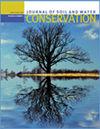长期排水循环水影响土壤健康和土壤性质
IF 2.6
4区 农林科学
Q2 ECOLOGY
引用次数: 1
摘要
在美国中西部,利用排水和地下灌溉(DSI)的排水水循环(DWR)提高了作物生产的弹性,改善了水质,但对土壤性质和土壤健康参数的影响尚未确定。本研究评估了:(1)长期DWR站点的水库养分浓度随时间的变化,(2)与自由排水(FD)和非排水(ND)土壤相比,DWR系统对玉米(Zea mays) -大豆(Glycine max L.)轮作中四个深度土壤性质的影响,以及(3)与ND相比,玉米-大豆轮作17年后DWR对土壤健康参数的影响。比较了不同的实验室方法对土壤健康参数的估计。在研究的最初几年(2002年至2007年),水库水中盐分(钾[K]和钠[Na])和溶解营养物(氮[N]和磷[P])的浓度较高。研究期间,水库中硝酸盐- n (NO3-N)的平均浓度为1.8 mg L−1,正磷酸盐(PO4-P)的平均浓度为0.36 mg L−1。水库中盐离子浓度不限制植物灌溉用水的使用。与ND相比,DWR处理在21 ~ 30 cm土壤深度的土壤质地中粉砂含量降低11% (P < 0.001),粘土浓度增加13% (P < 0.001)。地下水位波动影响了土壤中阳离子(钙[Ca]、镁[Mg]和钾)的运动,而FD和DWR处理的表层土壤试验磷含量较低。土壤分析方法与处理间无显著交互作用(P < 0.01),表明分析方法(哈尼土壤试验、土壤健康管理评价框架和康奈尔土壤健康评价)对土壤性质评价没有影响。DWR没有改变土壤性质或土壤健康参数。本文章由计算机程序翻译,如有差异,请以英文原文为准。
Long-term drainage water recycling affects soil health and soil properties
Drainage water recycling (DWR) using drainage and subirrigation (DSI) has increased the resiliency of crop production and improved water quality in the midwestern United States, but the effects on soil properties and soil health parameters have not been determined. This research evaluated (1) reservoir nutrient concentrations of a long-term DWR site over time, (2) the effects of a DWR system on soil properties at four depths in a corn (Zea mays)–soybean (Glycine max L.) rotation compared to free drainage (FD) and nondrained (ND) soil, and (3) the influence of DWR on soil health parameters after a 17-year corn–soybean rotation compared to ND. Different laboratory methods for estimating these soil health parameters were compared. In the initial years of the study (2002 to 2007), concentration of salts (potassium [K] and sodium [Na]) and dissolved nutrients (nitrogen [N] and phosphorus [P]) were higher in the reservoir water. Mean concentrations were 1.8 mg L−1 for nitrate-N (NO3-N) and 0.36 mg L−1 for orthophosphate (PO4-P) in the reservoir during the study. The concentration of salts and ions in the reservoir were not restrictive for use as irrigation water for plants. The DWR treatment had a soil texture that was 11% lower in silt (P < 0.001) and 13% higher in clay (P < 0.001) concentration at 21 to 30 cm soil depth compared to ND. The water table fluctuations appeared to influence cation (calcium [Ca], magnesium [Mg], and K) movement in soils while the FD and DWR treatments had lower soil test P in the topsoil. No significant interaction in soil analysis methods × treatments were observed (P > 0.1), indicating the absence of an effect of analysis methods (Haney soil test, Soil Health Management Assessment Framework, and Cornell Soil Health Assessment) on assessment of soil properties. DWR did not alter soil properties or soil health parameters.
求助全文
通过发布文献求助,成功后即可免费获取论文全文。
去求助
来源期刊
CiteScore
4.10
自引率
2.60%
发文量
0
审稿时长
3.3 months
期刊介绍:
The Journal of Soil and Water Conservation (JSWC) is a multidisciplinary journal of natural resource conservation research, practice, policy, and perspectives. The journal has two sections: the A Section containing various departments and features, and the Research Section containing peer-reviewed research papers.

 求助内容:
求助内容: 应助结果提醒方式:
应助结果提醒方式:


